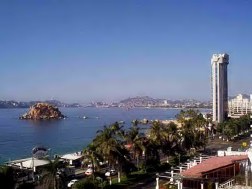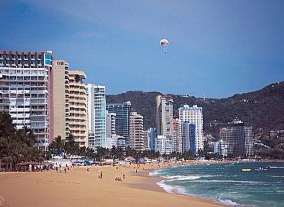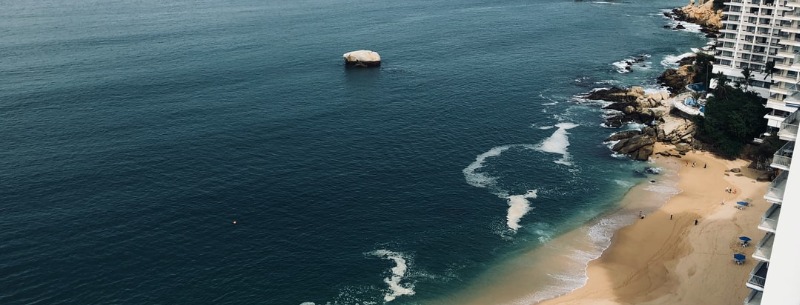Best Acapulco Beaches to Visit 2024
Everyone – even if they’ve not the remotest idea where it is – has heard of Acapulco, but few people know what to expect.
Truth is that, as long as you don’t yearn to get away from it all, you’ll find almost anything you want here, from magnificent beaches by day to clubs and discos by night.
What Acapulco undoubtedly has going for it, however, is its stunning bay: a sweeping scythe-stroke of yellow sand backed by the white towers of the high-rise hotels and, behind them, the jungly green foothills of the Sierra.
And, even though there are hundreds of thousands of people here throughout the year – the town itself has a population approaching one and a half million and even out of season (busiest months are Dec-Feb) most of the big hotels remain nearly full – it rarely seems oppressively crowded.
To get to the best of the sands around Acapulco Bay from the centre of town, you’re going to have to get on the bus: there is a tiny beach right in front of the town but it’s not in the least inviting, with grey sand made greyer by pollutants from the boats moored all around it.
Along Costera and on to Revolcadero
The main beaches, despite their various names – Hamacas, Hornos, Hornitos, Morro, Condesa and Icacos – are in effect a single sweep of sand.
It’s best to go some considerable distance round to Playa Condesa or Playa Icacos, in front of hotels like the Hyatt Regency and the Casa Inn, or opposite the Centro Acapulco, where the beach is far less crowded and considerably cleaner. Here, too, it’s easy enough to slip in to use the hotel showers, swimming pools and bars – there’s no way they’re going to spot an imposter in these thousand-bed monsters.
The Hyatt, at the very far end, is the swankiest of the bunch. The beaches around here are also the place to come if you want to indulge in such frolics as being towed around the bay on the end of a parachute, water skiing, or sailing. Outfits offering all of these are dotted at regular intervals along the beach; charges are standard though the quality of the equipment and the length of the trips can vary.
Beyond this end of the bay to the south are two more popular beaches: Puerto Marques and Revolcadero. On the way you’ll pass some of the fanciest hotels in Acapulco.
Las Brisas, overlooking the eastern end of the bay, is probably the most exclusive of all, its individual villas offering private swimming pools and pink jeeps to every occupant. Puerto Marques (buses marked “Puerto Marques”) is the first of the playas, a sheltered, deeply indented cove with restaurants and beach chairs right down to the water’s edge.
It’s overlooked by two more deluxe hotels – very calm, very upmarket, though the beach itself isn’t. You can continue by road to Revolcadero (though only an occasional bus comes this far) or get there by boat down a narrow inland channel.
The beach, a long exposed stretch of sand, is beautiful but frequently lashed by a surf that makes swimming impossible.
Caleta, Caletilla and La Roqueta
Playas Caleta and Caletilla (any “Caleta” bus from Costera) have a quite different atmosphere from those in the main part of the bay.
Very small – the two are divided only by a rocky outcrop and breakwater – they tend to be crowded with Mexicans (the foreign tourists who once flocked here have since decamped east), but the water is almost always calm and, by Acapulco’s standards, the beach is clean.
Most enticingly, you can sit at shaded tables on the sand, surrounded by Mexican matrons whose kids are paddling in the shallows, and be brought drinks from the cafes behind; not particularly cheap, but considerably less than the same service would cost at the other end of the bay.
There are showers here too and, on the rock, the Magic Mundo Marina, a water-sports complex similar to CiCi, with a predictable aquarium and sea-lion show, decent waterslides and a choice of the pool or the bay to swim in.
From outside the complex, small boats ply the channel to the islet of La Roqueta, where there are more and yet cleaner beaches, a small zoo and beer-drinking burros, one of the town’s less compelling attractions.
Whether you are off to La Roqueta or only going to Caleta, leave early (especially at weekends) for the best of the sun and at least a sporting chance of getting a beach chair or a patch of sand.
Behind the beach a group of moderately priced restaurants and cheaper loncherias offer good breakfasts and fish lunches.
Pie de la Cuesta
Pie de la Cuesta, around 15km north of Acapulco, is open to the vicissitudes of the ocean.
Definitely not for swimming – even if it weren’t for the massive backbreaking waves that dump on the beach, there are said to be sharks offshore – but as good a place as you can imagine to come and watch the sun sink into the Pacific or to ride horseback along the shore.
The sand extends for miles up the coast, but at the end nearer Acapulco, where the bus drops you, there are several rickety bars and some tranquil places to stay, away from the hubbub of the city.
Behind, and only separated from the ocean by a hundred-metre-wide sandbar on which Pie de la Cuesta is built, lies the Laguna de Coyuca, a vast freshwater lake said to be three times the size of Acapulco Bay, which only connects with the sea after heavy rains.
Fringed with palms, and rich in bird and animal life, the lagoon is big enough to accommodate both the ubiquitous noisy jetskiers and the more sedate boat-trips that visit the three lagoon islands.
Most boats stop on one island for lunch (not included in price) and swimming. The bus (“Pie de la Cuesta”) runs east every ten minutes or so past the zocalo along Costera. The last bus back leaves around 8pm.
Things to do in Acapulco
Perhaps the most popular attraction in Acapulco is, of course, their trademark sport, diving high from the cliffs of the city into the Pacific ocean below. The world famous La Quebrada cliff divers are physical artists who delight spectators most every day.
 If you’re an adventure traveler and enjoy water sports, you’ve come to the right place. You’ll find every imaginable water activity on the Bay and Pacific, including world class offshore fishing if you’re in the mood to get out on the water.
If you’re an adventure traveler and enjoy water sports, you’ve come to the right place. You’ll find every imaginable water activity on the Bay and Pacific, including world class offshore fishing if you’re in the mood to get out on the water.
You could also easily divide Acapulco into two cities occupying the same space: the Acapulco by day and the Acapulco by night.
If you’re not into the party scene, don’t despair. There are a number of quality attractions and activities to occupy your time away from the beach.
Plaza Álvarez or Zócalo
It is the main plaza in the City and one of the few spaces that show architectonic features of the old Acapulco. It is a quiet place with refreshing fountains of water, varied vegetation and benches luring you to take a break.
Cathedral of Our lady of Solitude
Its simple architectonic features show Spanish and Moor influences, with outstanding domes similar to the Byzantine towers of the mesquites. Its interior is decorated with glazed tiles while the floor is covered with golden mosaics. It was built in 1930 and it worked as a film set before becoming a temple.
Fort of San Diego
It was built by the Spaniards to protect themselves from the pirates that razed the coasts of Acapulco with the purpose of attacking the Galleons of Manila and Nao, which returned from the east loaded with valuable goods.
The Fort was refurbished in 1776. It is made of stones with a pentagonal shape, and protecting moats surrounding its numerous precincts. It is situated on N° 1 Hornitos Street, Colonia Centro and is currently the seat of the Historic Museum of Acapulco.
Historic Museum of Acapulco
Its 10 rooms house permanent and temporary exhibitions that reflect Acapulco’s history, since the first human vestiges found (3000 BC) until our days, passing by the Spanish conquer, the commercial relation with the east, the attacks of pirates and corsairs, and the Mexican revolution. Besides, it hosts music performances and plays.
Dolores Olmedo Art Gallery
It is the house of a renowned patron and art collector and a cultural corner in Acapulco. Amongst her priceless artworks there is an outstanding mural by Diego Rivera, who made use of his stay in 1956 to paint the god Quetzalcóatl, whom he represented as a feathered serpent. The Gallery is on 4455 Miguel Alemán Coastal Avenue.
Ecumenical Chapel of Peace
Mr and Mrs Trouyet decided to create a space of harmony and spirituality on the highest zone of Acapulco, which would welcome believers of all religions without any distinction whatsoever. That is how this Chapel was born and its 42-metre high cross can be watched from any place in the City.
Located in the exclusive zone of Las Brisas, the Chapel has a vantage point that offers an impressive panorama of Acapulco’s Bay.
Acapulco International Convention Centre
It is the cultural core of the City. It has theatres such as the Netzhualcoyotl and the Juan Ruiz de Alarcón, where colorful folkloric presentations with music and dances of the region take place. It has an extension of 43 acres and its architectonic design shows modern and pre-Hispanic features.
Noa Noa Crafts Market
Located in the zone of Hornos, it gathers beautiful and singular works full of creativity and good taste. The objects made with mineral and precious stones stand out. The prices are also very interesting.
Papagayo Roller Park
Also known as Ignacio Manuel Altamirano, it has a 21-hectare extension “sown” with children playgrounds, slides, a scenic train, pedal boats, an ice skating court, and even an ancient Spanish galleon. It is very close to downtown Acapulco, between Insurgentes and Avilés Avenues.
 Of course, there’s more to do after dark besides counting the discos where you lost your wallet. There are a number of great restaurants, though most are on the pricey side. But there are local favorites as well and worth the effort to ask around about.
Of course, there’s more to do after dark besides counting the discos where you lost your wallet. There are a number of great restaurants, though most are on the pricey side. But there are local favorites as well and worth the effort to ask around about.
There’s nothing wrong with a little after dark nightcap either and there are a number of small water front bars from which to choose, or the elegance of one of many upscale watering holes located all across the sprawling cliffside city.
If you are into dancing and romancing, bring lots of money. There’s a party on every corner, some are very formal affairs and require invitation, others do not.
Because of its size and success as a tourist attraction, take caution when moving about, especially after dark. Stay to the well trafficked and lighted areas, and in larger groups if possible. While crime is probably no worse than any other large tourist city, there are predators out to victimize you.
Sure, given a choice, the backcountry attractions of Mexico by far have the most appeal to the off-the-beaten-path traveler. And this is a good thing. But sometimes the soul gets thirsty for the kind of satisfaction that only a cheeseburger or a movie can bring, and those of us that enjoy the backcountry are allured into the city by the tempting lights.
Go ahead, there’s still a little gold in Acapulco. Take in a nice hotel room and a hot shower; sip on a pina colada by the bay, moving to the thick Latin rhythms of the night. Life is good man, and tomorrow can be the start to that next grand adventure down the highway to the jungles of Chiapas or the lofty heights of the Sierra Madres.
